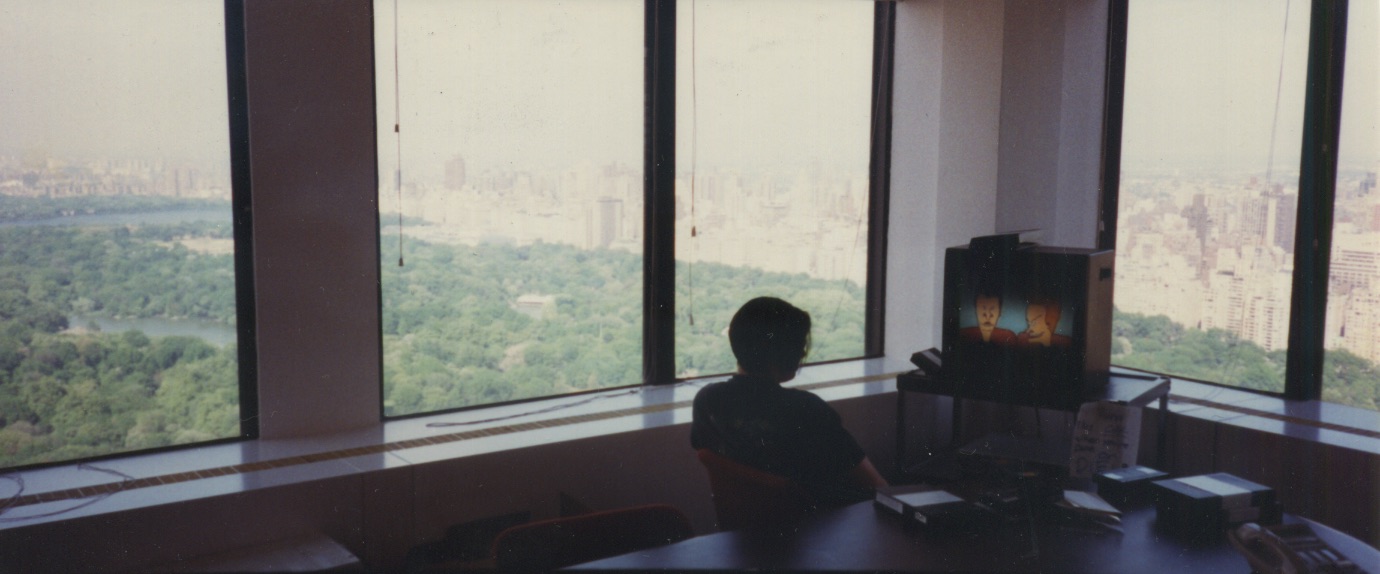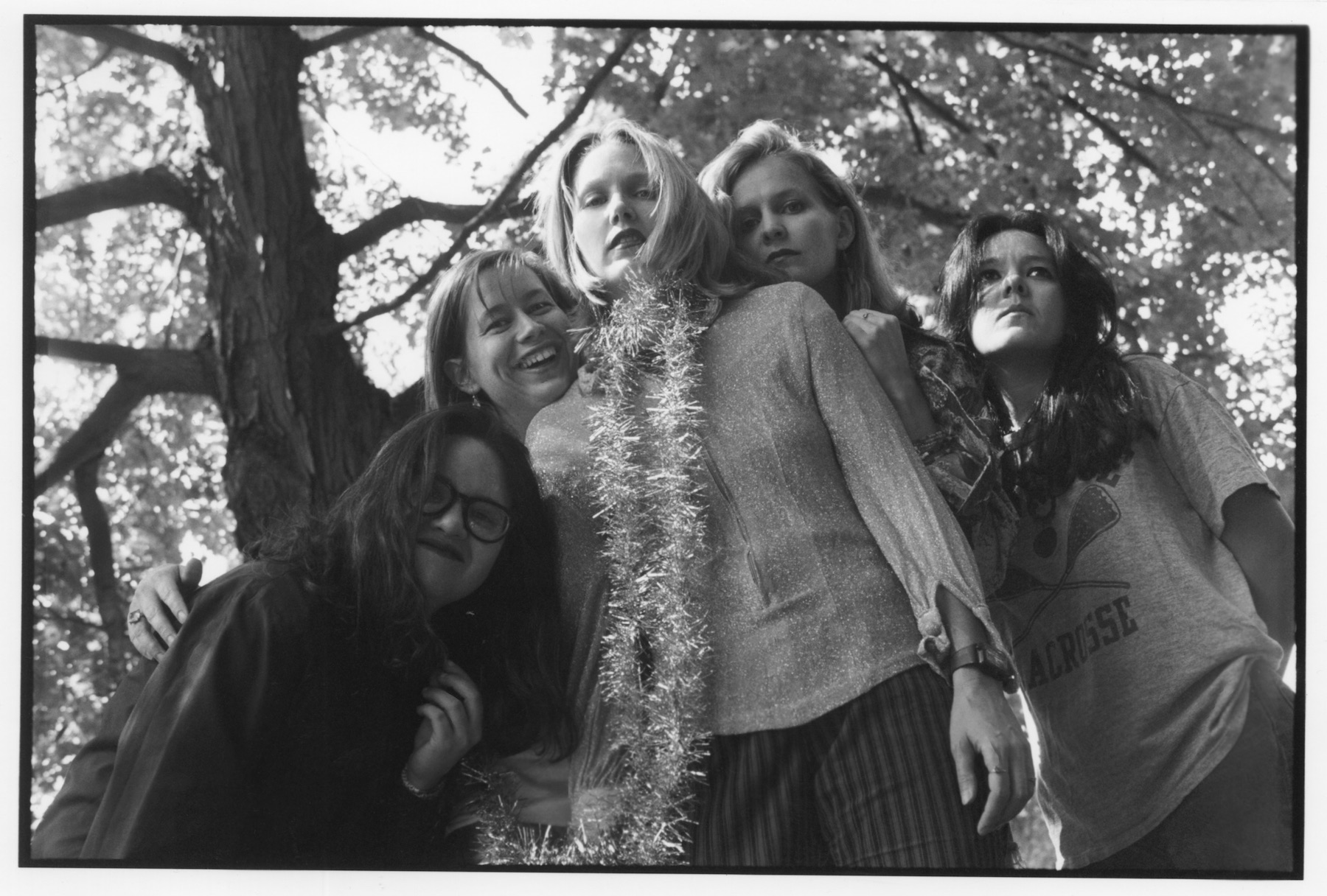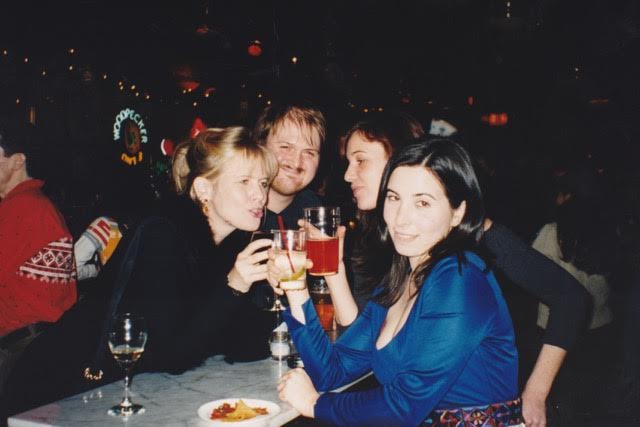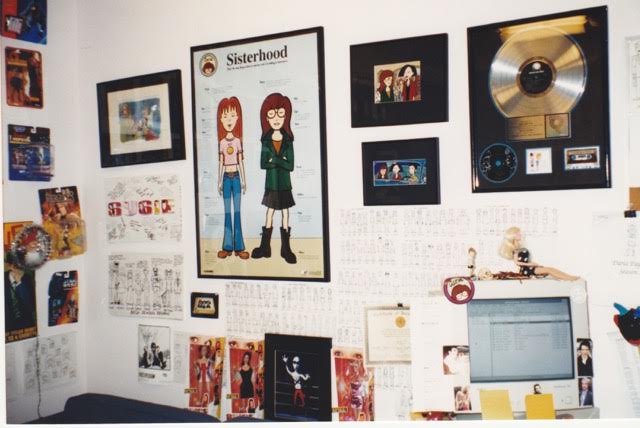In the summer of 1994, MTV needed Daria. The network was basking in the success of Beavis and Butt-Head, the iconic Mike Judge creation about a couple of dopey metal-heads who obsessed over music videos and explosions––but while it seemed like every young boy in the world was watching, hardly any girls were tuning in. That’s where Daria Morgendorffer came in—a quick sketch on the back of a paper plate that became a recurring Beavis and Butt-Head character and, eventually, the star of a standalone series.
Daria was put together by Harvard-educated Lampoon alum Glenn Eichler and Susie Lewis, who spent her days at Temple University doodling MTV logos on notebooks until a classmate suggested she get an internship at the network. His book smarts combined with her street smarts and pop culture knowledge, in a dynamic not dissimilar to that of Daria and her best friend, Jane Lane. They made their project work without a singular creative mastermind like Judge, who wanted nothing to do with the spin-off and was on his way out the door to bigger (and much more lucrative projects) with Fox anyway.
Videos by VICE
Daria ended up being the longest-running show to come out of MTV’s Animation department, surpassing even Beavis and other cultural touchstones like Celebrity Deathmatch. Although MTV would go on to produce other great cartoons, many lasted no more than one season, and none were able to replicate Daria’s success. In light of Daria turning 20 on March 3, I called up all the people behind the deadpan smart-aleck classic to ask how it got made, and why MTV will probably never have another animated mega-hit.

Beavis producer David McGrath on the top floor of what is now the Trump International Hotel and Tower. Photo by William Hartman.
David Felton, Beavis and Butt-Head writer and creator of the character Daria Morgendorffer): The reason MTV had to do long-form shows was that it was the only way you could get a [Nielsen] rating—and a rating was the only way you could get advertising.
Abby Terkuhle, founder and president of MTV Animation: I had a professor in college who exposed me to animation from Eastern Europe, as well as animation that was used to communicate political and social issues—which you didn’t always see in Disney, or America. I saw the possibility of animation that could be targeted to an older audience, [rather] than just kids.
Glenn Eichler, co-executive producer: The second they put Beavis and Butt-Head on the air, it was this huge hit—so then they needed writers. We had an editorial department, so all of a sudden everyone became animation writers.
John Garrett Andrews, supervising producer: One of the early comments from MTV president Judy McGrath was that [Beavis and Butt-Head] didn’t have any smart people, or women, or girls.
Felton: Beavis and Butt-Head were very sexist. Women didn’t like the show because all they talked about were boobs—even though [the characters] were so naive that they never had sex at all. I don’t think they would’ve known what to do if they had the chance [to have sex].
Susie Lewis, co-executive producer: I don’t think I would’ve ever watched Beavis and Butt-Head if I hadn’t been picking out the videos for it.
William Hartland, storyboard artist: I had an art school friend who was asked to animate something really sexist for Beavis, and she just quit. She said, “I can’t do this.”
Andrews: At that point, Mike Judge wasn’t overly confident about drawing female characters. One day, we were having a meeting with the studio and I drew a version of Daria on a paper plate.
Tracy Grandstaff, voice of Daria Morgendorffer: I was the only female writer on the Beavis staff at the time, so I was the default choice [for Daria]. Janeane Garofalo from the Ben Stiller Show [was a Daria influence] for sure, as well as my own personal inner dialogue from junior high and high school in Kalamazoo, Michigan—and Sara Gilbert from Roseanne, probably more than anyone.
Felton: In my script, Daria was ordered to work with Beavis and Butt-Head on a science experiment because their project was a disaster. It seemed like it would be interesting if they had someone to back them up who was a female, but not a sexual object. They certainly didn’t think of her in sexual terms—they’d ask her about sexual things, but they called her “Diarrhea” instead of “Daria.”

The crew of Beavis and Butt-Head relax in Central Park in 1995. Photo by William Hartland.
Andrews: In the summer of ’94 or ’95, it started coming down from the top of MTV that we needed a show for girls. We’d covered boys already with Beavis and Butt-Head
Grandstaff: MTV was going through a phase where they were getting a lot of flak for not really representing women on the air, outside of Spring Break.
Eichler: They did an animated show called Æon Flux—a superhero wearing, like, three inches of cloth as her entire outfit. They couldn’t have guessed more incorrectly about what young women wanted to watch.
Andrews: We did five pilots with female leads. There was one called Sneeze Louise, which was a girl who would sneeze when people were lying. There was another one called Dracworld, which was kind of pre-Twilight. There was one called Missy the Two-Headed Girl, who was two personalities in one body—and one just called Cartoon Girl. We were down to almost no more pilot money after the first four were shot, and I said to Abby Terkuhle, “Why don’t we spin Daria off to her own series?” He was open to it, so I called Mike Judge, who said, “I don’t mind as long as I don’t have to do anything.” We had money left for a storyboard shot to a track, which was enough to get the point across.
Wendy Hoopes, voice of Jane Lane, Helen, & Quinn Morgendorffer: I’d just graduated from NYU, and I sent a tape over to MTV with a letter saying that I’d love to do voices for them on Beavis and Butt-Head—but also, wouldn’t it be great to do a girls show in that vein, but smart. I got a call, but I was out of town, so I asked them to keep me in mind for the future. About six months later, I got a call from Susie Lewis, who said that she and Glenn were doing a [Beavis and Butt-Head] spin-off. I came in, we talked about several different characters, and I played around with voices for Quinn, and Jane, and Helen. I created these voices just sitting in a room with her, hearing how she perceived these characters.
Eichler: In the pilot, “Sealed with a Kick,” Daria got insulted or something by Kevin the quarterback, so she bakes him some cookies and gets some kind of revenge on him.
Andrews: Daria tested the best out of the pilots, but MTV didn’t like the fact that it tested the strongest with junior high kids. They were maintaining the fiction that their core audience was 18 to 24—but those people are in or just out of college. They’re not watching MTV—they’re busy actually having a life.
Eichler: I think the fact that it tested well had to do with the fact that the audience recognized her from Beavis and Butt-Head. That was fortuitous, to say the least.
Andrews: When they decided to do the spin-off, they offered it to Glenn Eichler, partly because he was a huge fan of My So-Called Life. He had a feeling for who this character would be if we built her out. Glenn was the polar opposite of Mike Judge—who came from Texas, worked everything out himself, taught himself animation, and studied comedy by watching Letterman. Glenn was a Harvard Lampoon guy, and to be quite honest, Mike wasn’t much of a fan of Glenn.
Hoopes: The animatic we did got picked up and it went from there. They actually asked me if I wanted to write on the show, but I’m an actress by trade.
Lewis: Glenn and I were both really involved in the pilot, so it became, ‘Do you guys wanna do this?’

Daria co-creators Susie Lewis and Glenn Eichler at the MTV Animation offices at 1633 Broadway in NYC. Photo courtesy of Susie Lewis.
Felton: Glenn’s a really good writer, but much more literate [than I am]. I’m a good writer about stuff that’s really stupid.
Grandstaff: Daria really was a 40-year-old man living in Bloomfield, New Jersey. She’s Glenn Eichler to the core.
Terkuhle: I think of Daria as Glenn Eichler in a dress.
Lewis: I feel like I brought a lot of “hipness” to the show, because I was closer to the characters’s ages at that time. I also had seen almost every music video that had ever been on MTV, because that was my job at Beavis.
Hoopes: I think Daria was a combination of both Glenn and Susie. That was the beautiful thing about Daria––there was a lot of sentimentality written into the characters, but it wasn’t just one generation of thought.
Karen Disher, supervising director: MTV put out a casting call to all the artists at the studio and said anyone was welcome to submit ideas of what Daria would look like if she moved away from Highland and into her own universe. The only directive was to keep her familiar but make her a little less rumpled and a little slicker.
William Hartland, storyboard artist: The only thing they kept out of my sketches was the fact that I used to use these Japanese pens that made these really thick lines.

The sketches that animator William Hartland suggested for the look of Daria that didn’t get chosen.
Disher: Eventually they winnowed it down to three choices before picking my Daria. To a traditional animator, working on the show might’ve been very frustrating, because you might have all these urges to be trippy and insane, but it was a very constrained style. It was very specifically meant to feel like a slice of real life.
Hartland: I like things that are beautifully animated, but Daria just wasn’t about that—it was about dialogue and what was happening at the time. I only lasted one season.
Andrews: Real World and Road Rules were a big deal at the time, and those shows would use whatever music was popular on the network, so that was the approach we took on Daria.
Lewis: This was a time when record labels just wanted MTV to play their music. I remember using “Girls Just Wanna Have Fun” in a mall scene with Quinn, but other than that, I always wanted to hear different music [in the show]. I’d listen to CDs I’d get sent for hours, scouring for the perfect lyric to go with the animation.
Janet Wygal, vocalist and guitarist for Splendora: We had to write and basically audition to do the theme song. The cellist in our band, Cindy Brolsma, was a producer on Daria, so there was a little nepotism involved. We did have to compete against other bands for the gig, and though I don’t know who those bands were, I can imagine that many of them had connections to the show as well, since there wasn’t a public audition call, as far as I know.
Andrews: Splendora worked with Glenn Eichler, who wrote lyric, “you’re standing on my neck.” Cindy was confident that Janet and the band could come up with a take on it.

Left to right: Cindy Brolsma, Jennifer Richardson, Janet Wygal, Tricia Wygal, Delissa Santos. Photo credit: Patricia Brolsma.
Janet Wygal: There’s a certain deadpan quality in the singing of the theme song—there was emotion, but it was very salty-sweet and sardonic. It was a melding of two styles, because our band already had a bit of that.
Tricia Wygal, vocalist and bassist for Splendora: MTV wanted a band that was pretty much unknown. It was hard to make the songs sound authentic—like they were ours—when we were given lyrics to use. We hadn’t written that way before.
Eichler: Writing Daria was a little bit more complicated than Beavis, because all of sudden we were writing half-hour sitcom scripts. But I read a couple of screenwriting books and took a shot. What I’m saying is, it’s not as hard as it looks.
Andrews: It was a very collegiate feeling. We were all learning how to have an animation studio together.
Hoopes: I had been coming up with cartoon voices since I was a child, although I hadn’t done cartoons prior to Daria.
Julián Rebolledo, voice of Jake Morgendorffer: It was probably my second audition ever. They had me read for every adult male teacher voice there was. I never had a young voice—even when I was 20, I sounded mature.
Marc Thompson, voice of Kevin Thompson, Mr. Demartino, and Mr. O’Neill: Daria was my first voiceover job. There was a posting on the cork board at NYU saying MTV was auditioning for a cartoon about vampires—they had a phone number and you literally were supposed to audition on the voicemail. That show didn’t go into production, but they said, “Hey, why don’t you also audition for this, too?”
Andrews: At that point, MTV didn’t do anything with SAG actors—nothing was union. When we started Beavis and Butt-Head, we used to just go to comedy clubs and try to find people with interesting voices.
Lewis: We had high-school performing arts kids come in to audition.
Rebolledo: When I saw the animation cells for what Jake looked like, he reminded me so much of Jimmy Stewart that I was doing an impression of him—and they booked me doing that. When I went to my first recording session, they decided they didn’t want me to do an impression, and I almost shat myself, because I thought I was gonna lose the job. On a dime, they wanted to go in a different direction. Luckily, I came up with something they liked.
Andrews: At some point, Glenn and Susie got it in their head that Tracy wasn’t deadpan enough, and that they really wanted to push this sort-of depressed sound. They started giving me cassettes with alternative voices that they thought were better, but I thought that Tracy was it. So we found her a vocal coach who worked with Broadway actors.

From left: Tracy Grandstaff (voice of Daria), John Bowen (sound editor), Wendy Hoopes (voice of Quinn, Helen and Jane), Ashley Albert (voice of Mrs. Barch, Tiffany, and others). Photo courtesy of Susie Lewis.
Grandstaff: They’d have me do ten takes in a row just to get it a little flatter, a little more even, a little more monotone.
Andrews: Even the acting coach was like, “What are we trying to do, make it sound like she’s on Quaaludes?”
Grandstaff: There was a bit of a showdown that ended with, “Look, she’s what’s established, let’s stick with this, this seems to be the right tone.”
Lewis: We really just made it up as we went. I often think about what’s required from a network today—where you have to have everything really planned out, know what’s happening with this character in season four, and what the story arc is.
Disher: The first couple of seasons, someone would draw the sketches, a person would paint them in, and then we’d put them under a camera and shoot them on film. Then we would take the film back and cut it on the old-timey machines, using slicers and tape and all that. Then we’d send everything out to have them fill it in because it was cheaper.
Hartland: Rough Draft Studios in Seoul.
Disher: If you look back at the first two seasons, you can see dirt flickering on the cells, or the color levels shifting. It looks awful because of the “technology” back then, or lack thereof.
Lewis: It wasn’t until the show was about to air that we had our doubts—of course, there was that feeling of wondering if anyone would get it. But the next day, it was clear that everyone got it.
Eichler: Daria was on Monday nights at 10:30, which was a weird time to be on the air. But eventually, for a little while, it was the highest rated show on MTV.
Grandstaff: The topicality of it was what I found to be pretty refreshing, even at the time. They’re talking about corporate sponsorship in public schools when the vending machine pops up, or the Jane Magazine takeoff where this hipster 30-something is trying to go into high school and establish trends for all the girls, and trying to co-opt stuff that young people are doing as her own trend-setting. They weren’t obvious topics in some cases, but they scratched the surface. They went a little deeper than, “Let’s just make Jane and Daria decide to go to a concert and meet guys.”

Susie Lewis’s office at MTV. Photo by Susie Lewis.
Hoopes: As the show went on, Daria became less defensive. And I think that was part of the nature of the show––when you’re in high school, you do go through so many changes emotionally and physically.
Eichler: When the show first aired in the first year, there were a lot of rabid fans. The minute Daria showed any vulnerability, some people declared that she jumped the shark.
Grandstaff: Toward the end, Daria started to see through Trent, which was heartbreaking. She got over the crush. Trent was cool, but not cool enough for her.
Eichler: The audience really did not like when she got a boyfriend, Tom. There was at least one guy who used to write really long detailed reviews on a website. He was super complimentary, but one day he just started hating us. Daria was echoing a place a lot of the viewers were in emotionally, but some of them just didn’t keep going with her.
Lewis: I ended up moving to California after season four, when the animation department was dying down a bit. MTV wanted to move on from all that programming, which is a shame.
Hartland: They brought in a new executive who just pushed animation out.
Eichler: Eventually, we’d done 65 episodes and two TV movies, each of which was at least three episodes long. There wasn’t really a lot left to say, or so I thought at the time.
Hoopes: Glenn’s idea was that was that he didn’t want them to stay in high school forever, and since they were growing up, he wasn’t sure where the show would go. But I do feel like maybe we ended when we were peaking—that there was still more to find.
Grandstaff: If it was still around, I’d hope that Daria and Jane would do something together, because I think that’s the one thing I think everyone was hoping would play out in the college years. Like, do they ever?
Eichler: Shortly after we ended Daria, MTV Animation ceased to be anyway. Animation costs a lot more to do than reality television, you know.
Terkuhle: Like any programming, it had to hit a bar, and animation was a little bit more expensive than some of the other reality programs. The audience’s taste changed, and we had to change with it. That’s just the business of television.
Andrews: They tried to bring Beavis back in 2011. It ran for a few weeks, and everyone was excited, but of course it was from a long time ago, and everyone who had tuned in for it was the old audience—it didn’t really take off again with the young audience. It was on for six weeks and then they just said, ‘Back to Jersey Shore.’
Follow Allie Conti on Twitter.
More
From VICE
-

Photo: Svetlana Iakusheva / Getty Images -

Photo: Marc_Osborne / Getty Images -

Photo: Gremlin / Getty Images -

Photo: Antoine Rouleau / Getty Images
